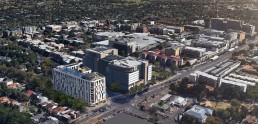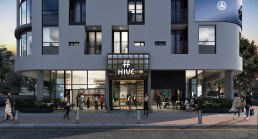The Hive concept has a truly remarkable origin. In their pursuit of a unique market offering, the client took an innovative approach by organizing a collaborative design session. This session was particularly notable for granting access to one of South Africa's largest collections of Lego* blocks, providing an immersive and engaging experience. Through this collaborative effort, both the client and our design team actively participated in a pragmatic and hands-on exploration of ideas. This collaborative spirit led to the development of a distinctive design solution that truly reflects the shared vision and input of both parties.
The #OXFORD HIVE concept represents more than just a new residential product; it encapsulates a vision for communal living in vibrant urban environments. Dubbed as 'Compact Dwelling', this innovative residential offering is meticulously crafted to thrive within bustling mixed-use precincts in prime locations. Beyond its architectural innovation, #Oxford Hive serves as a beacon for the concept of community within residential spaces. It stands as a pioneering example, potentially becoming the first residential building to embody the belief that a structure can serve as a physical manifestation of a diverse community, accommodating various aspirations and needs under one roof. Through thoughtful design and a commitment to fostering a sense of belonging, #Oxford Hive redefines the boundaries of residential living, elevating the concept of communal living to new heights.
Within the building's framework, diversity thrives among its occupants. Though there are 300 proposed Residential Units (299 Units, as one unit transitioned into a 3rd Party digital advertising billboard), there exist 41 distinct Unit Typologies, strategically distributed throughout the space. These typologies intertwine and interlock seamlessly, akin to pieces of a Chinese puzzle or a Tetris cube. As a result, the external facade breaks away from the conventional predictability found in most residential apartments. Instead, it mirrors the building's unique heterogeneity, each facet a reflection of the individuality of its diverse community members. In essence, the facade transforms into a rich tapestry, celebrating the myriad backgrounds, lifestyles, and stories that enrich the fabric of the building's population.
In conclusion, the exploration of the Tetris solution, with a nod to the historical concept of Multi-Level Dwelling, has yielded a significant breakthrough. The implementation of back-to-back Unit Typologies has resulted in a notable reduction in Common Area, streamlining passages and enhancing overall efficiencies within the structure. This innovative approach not only optimizes space but also underscores the importance of revisiting traditional architectural concepts in the pursuit of modern solutions. As we continue to push the boundaries of design, it is clear that inspiration drawn from both history and contemporary challenges can pave the way for transformative architectural solutions that benefit both residents and communities alike.





